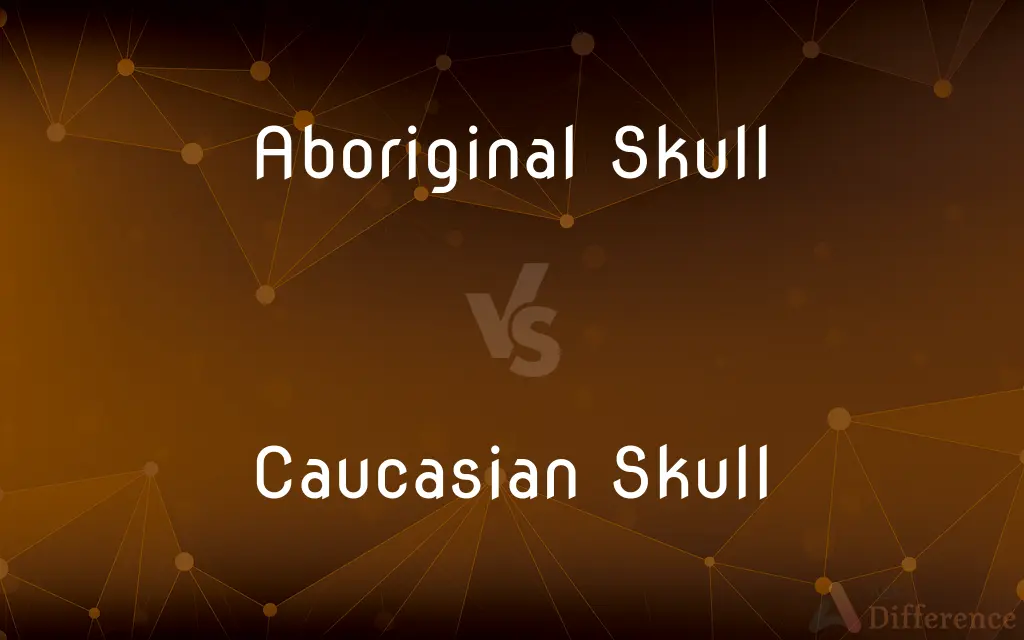Aboriginal Skull vs. Caucasian Skull — What's the Difference?
By Tayyaba Rehman — Published on November 4, 2023
The Aboriginal Skull is associated with indigenous peoples of Australia, characterized by certain cranial features, while the Caucasian Skull refers to people of European descent, with its distinct cranial characteristics.

Difference Between Aboriginal Skull and Caucasian Skull
Table of Contents
ADVERTISEMENT
Key Differences
The Aboriginal Skull pertains to the indigenous peoples of Australia, who have resided on the continent for tens of thousands of years. On the other hand, the Caucasian Skull is typically associated with populations of European descent, encompassing a diverse range of cranial structures due to vast European genetic variability.
Differences between the Aboriginal Skull and Caucasian Skull arise from distinct evolutionary, genetic, and environmental factors. The Aboriginal Skull may exhibit broader noses, pronounced brow ridges, and more robust features. In contrast, the Caucasian Skull might display a narrower nose, less pronounced brow ridges, and a rounder occipital region.
It's crucial to note that generalizations about the Aboriginal Skull and Caucasian Skull should be approached with caution. The diversity within each group can be significant, and these descriptions might not apply universally. Both skulls represent a spectrum of individual variations and adaptations.
Researchers and anthropologists often study the Aboriginal Skull and Caucasian Skull to understand human evolution, migration patterns, and adaptations to different environments. However, these investigations can sometimes be controversial, especially when misused to make general claims about racial or cultural superiority.
In summary, while the Aboriginal Skull and Caucasian Skull can exhibit certain distinguishing features, it's essential to recognize the vast intra-group diversity and avoid making overarching or prejudiced assumptions.
ADVERTISEMENT
Comparison Chart
Geographic Origin
Indigenous peoples of Australia
Populations of European descent
Notable Features
Broader noses, pronounced brow ridges, more robust structure
Narrower noses, less pronounced brow ridges, rounder occipital
Evolutionary Factors
Adaptations to Australian environment
Adaptations to varied European climates and terrains
Variability
Significant intra-group diversity
High genetic variability due to vast European populations
Use in Anthropological Study
Human evolution, migration patterns in Oceania
Human evolution, migration patterns in Europe
Compare with Definitions
Aboriginal Skull
A testament to tens of thousands of years of human existence in Australia.
The Aboriginal Skull provides insight into the long history of human life on the continent.
Caucasian Skull
A skull with features like a rounder occipital and narrower nose bridge.
Some Caucasian Skull samples display less pronounced brow ridges.
Aboriginal Skull
A physical representation of Australia's first inhabitants' cranial features.
Anthropologists study the Aboriginal Skull to trace migration patterns in Oceania.
Caucasian Skull
A physical marker used to study European ancestry and migration patterns.
Anthropologists use the Caucasian Skull to understand ancient European migrations.
Aboriginal Skull
A skull with distinct features like broader noses and robustness.
The pronounced brow ridges on the Aboriginal Skull are a distinguishing characteristic.
Caucasian Skull
A skull reflecting a wide range of European genetic and environmental adaptations.
The narrower nose observed in some Caucasian Skull samples may be an adaptation to colder climates.
Aboriginal Skull
A skull reflecting the genetic diversity of Australia's indigenous communities.
Variations in the Aboriginal Skull underscore the rich diversity of indigenous Australian groups.
Caucasian Skull
A testament to the rich history and diversity of European populations.
The Caucasian Skull embodies the complex tapestry of European history and genetics.
Aboriginal Skull
The cranial structure of the indigenous peoples of Australia.
The Aboriginal Skull shows adaptations suited for the Australian environment.
Caucasian Skull
The cranial structure associated with populations of European descent.
The Caucasian Skull can vary widely due to Europe's diverse genetic makeup.
Common Curiosities
What is the Aboriginal Skull?
The Aboriginal Skull refers to the cranial structure of indigenous Australians.
Why is it important to avoid generalizing about these skulls?
Both represent a spectrum of individual variations, and generalizations can lead to inaccurate or prejudiced assumptions.
Do environmental factors influence the development of these skulls?
Yes, adaptations to specific environments can influence cranial features over generations.
Can the Aboriginal Skull provide insights into ancient human migrations?
Yes, it offers clues about human migration patterns in Oceania.
Are all Aboriginal Skulls identical?
No, there's significant diversity within the indigenous Australian population.
How does the Caucasian Skull differ from the Aboriginal Skull?
They differ in cranial features due to distinct evolutionary, genetic, and environmental factors.
What are some distinguishing features of the Caucasian Skull?
Features might include a narrower nose and a rounder occipital, though there's substantial variability.
Share Your Discovery

Previous Comparison
Safe Mode vs. Normal Mode
Next Comparison
Contemporary Art vs. Traditional ArtAuthor Spotlight
Written by
Tayyaba RehmanTayyaba Rehman is a distinguished writer, currently serving as a primary contributor to askdifference.com. As a researcher in semantics and etymology, Tayyaba's passion for the complexity of languages and their distinctions has found a perfect home on the platform. Tayyaba delves into the intricacies of language, distinguishing between commonly confused words and phrases, thereby providing clarity for readers worldwide.
















































